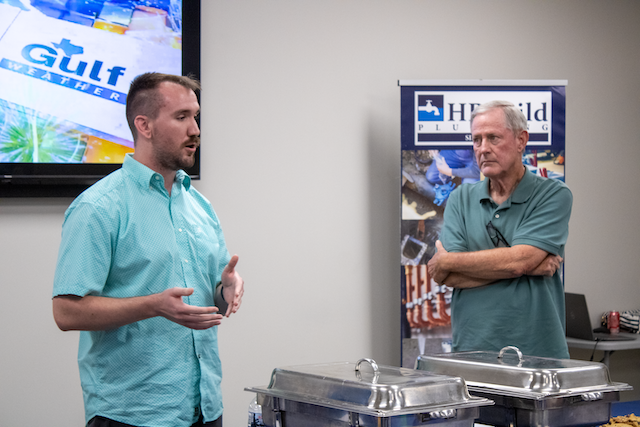Helping out with the long process of rebuilding
Published 3:48 pm Wednesday, September 27, 2017
The good deeds done after Harvey were not limited to rescuing people from their flooded homes; they now include restoring those flooded homes to something livable. After the Cajun Navy does their job, the Cajun Army begins theirs—and that’s where a Nederland resident is doing his good deeds.
Brandon Hammock works with the Cajun Army to repair and restore damaged homes caused by the floodwaters of Harvey. It’s a demanding job that requires time, effort and a certain sense of humor. As Hammock remarked if one’s not laughing, they’re crying.
“We live in Nederland. Our company is based out of Nederland, ABLOOM Property Solutions,” Hammock said of he and his wife.
Trending
“Our equipment, vehicles, all took on water. Our work force dried up overnight; and instead of twiddling our thumbs, we’re going out to do what we can.”
According to Hammock, it was witnessing the actions of the Cajun Army firsthand that inspired him to join their outfit.
“We happened upon the Cajun Army. They’re associated loosely with the Cajun Navy,” Hammock said. “They were down here fishing people out of houses when they got two members of our families out from their houses and to safety.
“I was just really impressed with the level of people and the level of their action. I thought, ‘This is an organization we want to be part of.’ So, we rolled up our sleeves and have been volunteering with them since.”
Hammock described the caliber of volunteers with the Cajun Navy and Army as “unreal” and commended the work they’ve been putting into affected areas.
He said they’ve had people come from as far away as Houston, Baton Rouge, Maryland and even one couple from Alaska to join in the rebuilding efforts along Southeast Texas.
Trending
“The response has been great,” he said.
From sunup to sundown, Hammock and the Army works; yet, their greatest contribution may very well be instructional. They get out important information for residents looking to rebuild.
“I’ve been doing my best to run logistics and be on the information campaign to spread awareness to the general public, to show folks the correct way to dry out and rebuild their houses,” Hammock said.
Hammock has worked in similar circumstances, citing the Deweyville flood along the Sabine River.
“There were lots of folks under-insured or not insured at all,” he said. “So, we volunteered with that effort.”
Hammock warned of putting up new sheetrock too soon, as several Deweyville residents did. Hammock said two weeks or two months after some residents put up the sheetrock, they had to rip it out all over again.
According to Hammock, it was because their homes had never been fully dried out; and, so when new materials were put up, the original moisture was still trapped inside.
“Most contractors and homebuilders are familiar with the nuances of rebuilding safely,” Hammock said. “But they (residents) don’t have that knowledge base unless they’ve worked with that flood experience.”
Hammock said most people don’t have the right experience—or tools—to properly gauge the moisture content of a house.
“Here we have whole houses where every stud has trapped moisture inside the stud (and) really the only way to know the moisture level is to have a moisture reader,” Hammock said.
He recommended residents get moisture readers with pins.
“Sticking pins into the wood is pretty important,” Hammock said. “The ones that don’t have pins are usually inaccurate readers.”
Hammock suggested homeowners look for pin-type readers in the $35 to $50 range.
“They’re like cars,” Hammock said. “You want the Ford or Chevy of moisture readers. You don’t need to spend $100 on the more expensive kinds.”
Hammock gives aid where he can, whether it’s in the form of physical labor or free education.
“We’ve been gutting houses for the past two weeks. We started with the first responders in Port Arthur, then moved to the elderly and disabled.”
When asked to give out the best piece of advice he could give to residents looking to rebuild as soon as possible, Hammock recommended patience. He referred to the waiting process as “a cold, sobering glass of water in the face” when it comes to evaluating one’s home after flood damage.
Along with having patience and knowledge, he referred residents to the one-page flier the organization has been handing out. On it one would find information regarding the cleaning and drying out process, tools, safety and more.
He recommended the moisture level in affected homes to be down at 15 percent or lower before rebuilding.
“If we can get this information out there,” Hammock said. “The level of ignorance out there is alarming. Ignorance in the literal sense—a lack of knowledge.”
To combat this ignorance, Hammock and volunteers have been reaching out to church groups, teachers, social media and anywhere else where the public could be exposed to such important information.
“With that information out there, they should be able to dry out their houses,” Hammock said.





